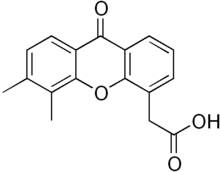Vadimezan
 | |
| Clinical data | |
|---|---|
| ATC code | none |
| Identifiers | |
| |
| Synonyms | ASA404, DMXAA |
| CAS Number |
117570-53-3 |
| ChemSpider | 110486 |
| UNII |
0829J8133H |
| ChEBI | CHEBI:75934 |
| ECHA InfoCard | 100.107.097 |
| Chemical and physical data | |
| Formula | C17H14O4 |
| Molar mass | 282.29 g/mol |
| 3D model (Jmol) | Interactive image |
| |
| |
| (verify) | |
Vadimezan or ASA404 (originally DMXAA)[1] is a tumor-vascular disrupting agent (tumor-VDA) that attacks the blood supply of a cancerous tumor to cause tumor regression.[2]
Clinical trials
Non-small cell lung cancer
Despite results at the preclinical stage, Vadimezan failed human clinical trials. Recent studies have demonstrated the reason for the inefficacy. Vadimezan was shown to target the STING pathway,[3] however, this effect is mouse specific; it has no effect on human STING.[4] A single amino acid difference at position 162 (S162A) of the cyclic-dinucleotide-binding site of STING makes mouse STING sensitive to the drug, whereas human STING remains insensitive.
Vadimezan had been studied in combination with chemotherapy in at least two Phase II trials for advanced non-small cell lung cancer (NSCLC) and showed survival extensions of around 5 months when compared to chemotherapy alone (14.0 months compared to 8.8 months).[5] [6] In April 2008, a Phase III trial started. In March 2010 the phase III trial of use as a first line therapy for NSCLC gave poor results.[7] Interim results on another phase III trial as second-line therapy for NSCLC were completed in 2011. In Nov 2010 the 2nd trial also gave poor interim results.[8]
Other cancers
As of February 2009 it was being studied for the treatment of prostate cancer[6] and HER2-negative metastatic breast cancer.[1][9]
History
ASA404 was discovered by Bruce Baguley and William Denny and their teams at the Auckland Cancer Society Research Centre at the University of Auckland in New Zealand.[9] It was licensed to Antisoma in 2001. Novartis acquired the worldwide rights for it in 2007 and it underwent development by Antisoma and Novartis.[6][9]
References
- 1 2 "New Zealand drug tested for breast-cancer fight". New Zealand Herald. 14 February 2009. Retrieved 2009-02-13.
- ↑ ASA404, A Novel Cancer Agent, Begins Pivotal Trial To Explore New Approach In Treating Lung Cancer, The Leading Cause Of Cancer Death, Medical News Today, 14 Apr 2008
- ↑ Prantner, D.; Perkins, D. J.; Lai, W.; Williams, M. S.; Sharma, S.; Fitzgerald, K. A.; Vogel, S. N. (2012). "5,6-Dimethylxanthenone-4-acetic Acid (DMXAA) Activates Stimulator of Interferon Gene (STING)-dependent Innate Immune Pathways and is Regulated by Mitochondrial Membrane Potential". Journal of Biological Chemistry. 287 (47): 39776. doi:10.1074/jbc.M112.382986. PMC 3501038
 . PMID 23027866.
. PMID 23027866. - ↑ Conlon, J.; Burdette, D. L.; Sharma, S.; Bhat, N.; Thompson, M.; Jiang, Z.; Rathinam, V. A. K.; Monks, B.; Jin, T.; Xiao, T. S.; Vogel, S. N.; Vance, R. E.; Fitzgerald, K. A. (2013). "Mouse, but not Human STING, Binds and Signals in Response to the Vascular Disrupting Agent 5,6-Dimethylxanthenone-4-Acetic Acid". The Journal of Immunology. 190 (10): 5216. doi:10.4049/jimmunol.1300097. PMC 3647383
 . PMID 23585680.
. PMID 23585680. - ↑ McKeage, M J; von Pawel, J; Reck, M; Jameson, M B; Rosenthal, M A; Sullivan, R; Gibbs, D; Mainwaring, P N; Serke, M; Lafitte, J-J; Chouaid, C; Freitag, L; Quoix, E (2008). "Randomised phase II study of ASA404 combined with carboplatin and paclitaxel in previously untreated advanced non-small cell lung cancer". British Journal of Cancer. 99 (12): 2006. doi:10.1038/sj.bjc.6604808. PMC 2607218
 . PMID 19078952.
. PMID 19078952. - 1 2 3 ASA404 Vascular Disrupting Agent for Solid Tumours, drugdevelopment-technology.com
- ↑ "Antisoma and Novartis Ditch ASA404 After Second Phase III NSCLC Trial Bombs". 11 Nov 2010.
- 1 2 3 "ASA404 to be developed in breast cancer". Antisoma. 12 February 2009. Retrieved 2009-02-13.